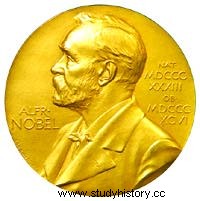The Germans Max von Laue and James Franck they received the Nobel Prize for Physics in 1914 and 1925 respectively. Von Laue was a recognized opponent of Nazism and Franck was Jewish; so, faced with the possibility that the gold medals of the Nobel prize could reach the hands of the Nazis, they were sent to the laboratory of Niels Bohr (Nobel Prize for Physics in 1922) in Copenhagen to keep them until the end of the war. At this point, we must remember that for the Nazi regime it was a crime to export gold and the medals were 23-karat gold.

Unfortunately, in 1940 the Nazis invaded Denmark. Niels Bohr knew that he would receive a «visit “From the Nazis since his laboratory had become a haven for Jewish physicists. Furthermore, if they found the medals of Max von Laue and James Franck, as their names were engraved on them, they would be accused of taking gold out of Germany. He had to hide them... where? The first option was to bury them but he rejected it. In the end, with the help of the Hungarian chemist George de Hevesy (Nobel Prize in Chemistry in 1943) decided to dissolve them .

Nobel Medal
It wasn't easy either, because one of the few reagents capable of dissolving gold and platinum is aqua regia (It is a highly corrosive solution, yellow in color, formed by a mixture of concentrated nitric acid and concentrated hydrochloric acid, generally in the proportion of one in three parts). They did so and when the Nazis arrived, to search the laboratory, the medals were dissolved in a test tube... they had them under their noses .
Hevesy was forced to flee to Stockholm in 1943; when the war was over he returned to his lab and found the test tube on the shelf where he had left it. He retrieved the gold and sent it to the Swedish Academy. The Nobel Prize Committee recast new medals, using the original gold, and returned them to their rightful owners.
Niels Bohr's Nobel medal had been auctioned on March 12, 1940 to raise money for Finnish Relief (Finnish relief). The winning bid was anonymous, but Mr. Anonymous later presented the Bohr medal to the Danish Fredriksborg Historical Museum, where it can be seen today.
Thanks to @JMNoticias for the idea
